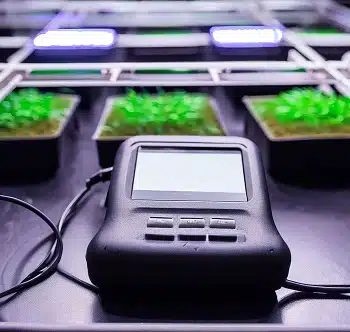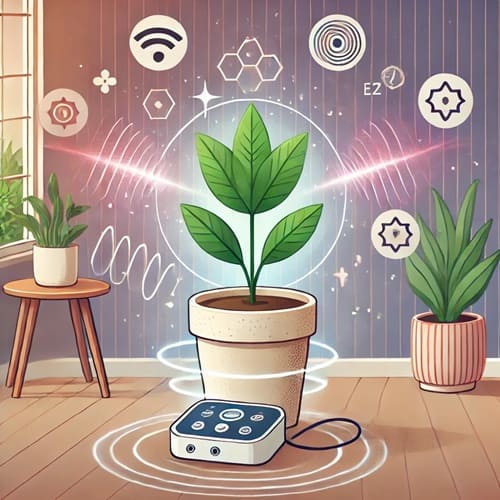Agricultural Bioresonance, Applications, and Benefits
Bioresonance, a concept rooted in quantum mechanics and biophysics, has shown promising applications beyond traditional medicine, extending into agriculture. This innovative approach leverages the natural electromagnetic frequencies emitted by all matter to enhance the health and productivity of plants. By addressing and correcting disruptions in intercellular communication, Bioresonance offers a sustainable and effective method to improve agricultural outcomes. Agricultural Bioresonance

The Science Behind Bioresonance
Wave-Particle Duality: Quantum physics reveals that all particles exhibit both wave and particle properties. This means that all materials, including cells, viruses, bacteria, and toxins, emit unique electromagnetic waves, known as “frequency patterns.” These patterns can be harnessed to monitor and influence biological processes.
Intercellular Communication: Research indicates that cells communicate with each other using photon radiation (light sources). This Biphotonic communication is essential for maintaining the proper functioning of biological systems. Disruptions in this communication can lead to various issues, such as poor cell function and disease.
Applications in Agriculture
Enhancing Plant Health: Just as Bioresonance therapy can identify and correct disruptions in human cells, it can also be applied to plants. By detecting the specific frequencies emitted by healthy and stressed plants, farmers can identify issues such as nutrient deficiencies, pest infestations, or disease at an early stage. Corrective measures can then be applied to restore optimal plant health.
Reducing the Impact of Stressors: Plants, like all living organisms, are subject to various stressors including toxins, pathogens, and environmental factors such as ultraviolet radiation. Bioresonance can help mitigate the impact of these stressors by enhancing the plant’s natural defense mechanisms and improving its resilience.
Sustainable Farming Practices: Bioresonance offers a sustainable alternative to traditional agricultural practices that rely heavily on chemical inputs. By improving plant health naturally, farmers can reduce their reliance on pesticides and fertilizers, leading to more sustainable and eco-friendly farming methods.
Practical Implementation
Soil and Water Treatment: Bioresonance devices can be used to treat soil and water, ensuring they are free from harmful substances and optimized for plant growth. By improving the quality of these fundamental resources, the overall health and productivity of crops can be enhanced.

Monitoring Crop Health: Portable Bioresonance devices allow farmers to regularly monitor the health of their crops. These devices can detect early signs of stress and disease, enabling timely interventions that can prevent larger issues from developing.
Improving Yield and Quality: By maintaining optimal health and minimizing the impact of stressors, Bioresonance can help increase crop yields and improve the quality of agricultural products. Healthier plants produce better fruits, vegetables, and grains, which can lead to higher market value and better food security.
The integration of Bioresonance therapy into agriculture represents a significant advancement in sustainable farming practices. By leveraging the natural electromagnetic frequencies of plants, Bioresonance offers a non-invasive, eco-friendly method to enhance plant health and productivity. As research and technology continue to evolve, the potential applications of Bioresonance in agriculture are likely to expand, paving the way for more resilient and sustainable food production systems.
The Future of Agricultural Bioresonance
As the global agricultural industry faces increasing challenges such as climate change, food security, and sustainability, innovative technologies are emerging to address these issues. Among these, bioresonance is gaining attention for its potential to revolutionize farming practices by leveraging the natural electromagnetic frequencies of plants to enhance growth, health, and productivity.
Understanding Bioresonance
Bioresonance therapy is based on the principle that all matter, including living cells, emits unique electromagnetic frequencies. By detecting and correcting disruptions in these frequencies, bioresonance aims to restore optimal cellular communication. In agriculture, this technology can be used to monitor plant health, detect stressors early, and apply corrective measures to improve crop yield and quality.

Advancements in Bioresonance Technology
Integration with Digital Agriculture
Digital agriculture technologies, such as IoT devices, drones, and automated systems, are transforming farming by providing real-time data on soil conditions, crop health, and environmental factors. When combined with bioresonance, these technologies can offer a comprehensive approach to monitoring and managing crops more efficiently. Farmers can use bioresonance devices to scan plants and detect electromagnetic anomalies, which can then be addressed to prevent disease and optimize growth.
AI and Data Analytics
The integration of AI technologies, including generative and analytical AI, is enhancing the capabilities of bioresonance in agriculture. These AI systems can analyze vast datasets to identify patterns and predict outcomes such as pest infestations, weather impacts, and crop yields. By combining AI with bioresonance, farmers can make data-driven decisions to improve resource use and maximize productivity.
Benefits of Bioresonance in Agriculture
Enhanced Crop Health and Yield
Bioresonance can improve plant health by detecting and correcting disruptions in cellular communication. This allows for early identification of stressors like nutrient deficiencies, pests, and diseases, enabling timely interventions that enhance crop yield and quality.
Sustainability and Eco-Friendliness
By enhancing the natural defense mechanisms of plants, bioresonance reduces the need for chemical inputs such as pesticides and fertilizers. This contributes to more sustainable and eco-friendly farming practices, aligning with the global push towards regenerative agriculture. Sustainable farming practices not only benefit the environment but also improve the long-term viability of agricultural operations.

Resource Efficiency
Bioresonance technology can help optimize the use of resources such as water and nutrients. By providing precise data on plant needs, farmers can apply resources more efficiently, reducing waste and lowering production costs. This is particularly important in regions facing water scarcity and other resource limitations.
Challenges and Considerations
- Accessibility and Adoption: While large farms with significant resources are likely to adopt bioresonance and related technologies quickly, smaller farms may face challenges due to the initial costs and technical expertise required. Efforts to make these technologies more accessible and affordable are crucial for widespread adoption and ensuring that all farmers can benefit from the advancements.
- Research and Development: Continued research and development are essential to fully understand the potential and limitations of bioresonance in agriculture. Collaborative efforts between researchers, technology developers, and farmers will be key to refining and implementing these technologies effectively. Investing in R&D will help address any technical challenges and improve the accuracy and reliability of bioresonance devices.
Conclusion
The future of agricultural bioresonance is promising, with the potential to significantly enhance sustainability, efficiency, and productivity in farming. By leveraging the natural electromagnetic frequencies of plants and integrating advanced technologies like AI and IoT, bioresonance offers a path towards more resilient and sustainable agricultural practices. As research and technology continue to evolve, the adoption of bioresonance in agriculture is likely to expand, providing innovative solutions to the challenges faced by the global agricultural industry.


